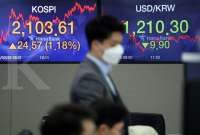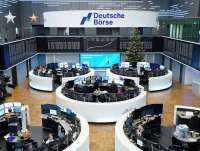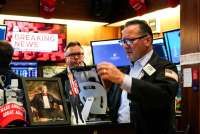GLOBAL ECONOMY - WASHINGTON. U.S. job growth slowed in July and manufacturers slashed hours for workers, which together with an escalation in trade tensions between the United States and China could give the Federal Reserve ammunition to cut interest rates again next month.
The Labor Department's closely watched monthly employment report on Friday came a day after President Donald Trump announced an additional 10% tariff on $300 billion worth of Chinese imports starting Sept. 1, a move that led financial markets to almost fully price in a rate cut in September.
The U.S. central bank on Wednesday cut its short-term interest rate for the first time since 2008. Fed Chairman Jerome Powell described the widely anticipated 25-basis-point monetary policy easing as insurance against downside risks to the 10-year old economic expansion, the longest in history, from trade tensions and slowing global growth.
"There has been some slowing, and yesterday's tariff announcement suggests more trade-related weakening in the months ahead," said Jim O'Sullivan, chief U.S. economist at High Frequency Economics in White Plains, New York. "We still expect the Fed to ease again at the September meeting."
Nonfarm payrolls increased by 164,000 jobs last month, the government said. The economy created 41,000 fewer jobs in May and June than previously reported. July's job gains were in line with economists' expectations.
The average workweek fell to its lowest level in nearly two years in July as manufacturers reduced hours for workers, a sign that economic growth slowed further early in the third quarter.
The U.S.-China trade war is taking a toll on manufacturing, with production declining for two straight quarters. Business investment has also been hit, contracting in the second quarter for the first time in more than three years and contributing to holding back the economy to a 2.1% annualized growth rate. The economy grew at a 3.1% pace in the first quarter.
The White House's "America First" policies are also restricting trade flows. A separate report from the Commerce Department on Friday showed sharp declines in both imports and exports in June, leading the trade deficit to dip 0.3% to $55.2 billion during the month.
The July payrolls marked a further deceleration in job growth from an average of 223,000 per month in 2018. Economists say it is unclear whether the loss of momentum in hiring was due to ebbing demand for labor or a shortage of qualified workers.
Still, the pace of job growth remains well above the roughly 100,000 needed per month to keep up with growth in the working-age population. The unemployment rate was unchanged at 3.7% in July as 370,000 people entered the labor force.
Despite the lowest jobless rate in nearly 50 years, wage gains remain moderate, contributing to a tame inflation environment, which could be supportive of a rate cut next month. Inflation has undershot the Fed's 2% target this year, rising 1.6% on a year-on-year basis in June after a 1.5% gain in May.
Average hourly earnings rose 8 cents, or 0.3%, in July, after the same increase in June. That lifted the annual increase in wages to 3.2% in July from 3.1% in June. The trend in wage gains has slowed from late 2018 when wages were rising at their fastest rate in a decade.
Fed funds futures implied traders saw a roughly 94% chance of the Fed cutting rates again next month, according to CME Group's FedWatch tool.
Prices of U.S. Treasuries were trading higher while the dollar was weaker against a basket of currencies. U.S. stocks fell.
SLOWING ECONOMY
Even with the step-down in employment growth and moderate wage gains, the labor market is supporting the economy as the stimulus from last year's $1.5 trillion tax cut package fades.
Economic growth in the third quarter is seen at around a 1.5% rate. The labor force participation rate, or the proportion of working-age Americans who have a job or are looking for one, rose to 63.0% in July from 62.9% in June.
A broader measure of unemployment, which includes people who want to work but have given up searching and those working part-time because they cannot find full-time employment, fell two-tenths of a percentage point to 7.0% last month, the lowest level since December 2000.
Construction payrolls increased by 4,000 jobs after shooting up by 18,000 in June. Manufacturing employment rose by 16,000 jobs after increasing by 12,000 in June. The strong manufacturing job gains are at odds with weakening activity in the sector. A survey on Thursday showed manufacturing employment hit its lowest level since November 2016 in July.
The weakness was underscored by another report on Friday from the Commerce Department showing factory orders rising less than expected in June and unfilled orders shrinking further.
The sector, which accounts for more than 12% of the U.S. economy, is being hobbled by trade tensions, weakening global growth, an inventory bulge - concentrated in the automotive industry - and design problems at aerospace giant Boeing Co . Factory workers put in fewer hours last month.
The manufacturing workweek dropped 0.3 hour to 40.4 hours, the lowest since November 2011. That contributed to the overall average workweek falling to 34.3 hours, the fewest since September 2017, from 34.4 hours in June.
Factory overtime dropped by 0.2 hour in July to 3.2 hours.
"The drop in aggregate hours suggests production weakened even more than hiring," said Chris Low, chief economist at FTN Financial in New York.
Government employment increased by 16,000 jobs in July, boosted by local government hiring, adding to June's gain of 14,000. Professional and business services employment rose by 38,000 jobs last month.
There were also increases in healthcare, leisure and hospitality, financial activities and wholesale trade employment. But retail payrolls dropped by 3,600 jobs, declining for a sixth straight month.
/2019/03/18/439373173p.jpg)









